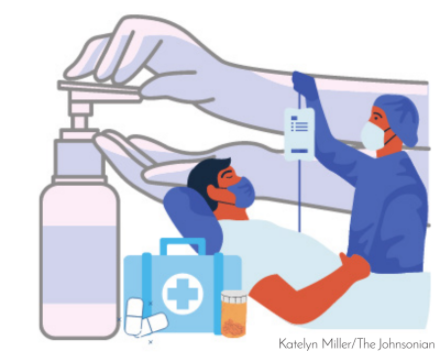As one of the greatest challenges of the year, researchers and scientists persist in the race to develop a treatment for the COVID-19 pandemic. Although controversy has risen from recent widespread discussions of approaches to vaccinations and medicine, some potential treatments show great promise.
According to the FDA, more than 550 drug development programs are in initial stages, over 350 trials have been reviewed, and five treatments are authorized for emergency use as of September 30.
One of these treatments for emergency use, Veklury, or Remdesivir, is an antiviral drug. This means that it targets and inhibits further development of viruses. Although clinical trials do not indicate Remdesivir has any impact on mortality rates, it has demonstrated promise.
“In hospitalized patients with mild to moderate disease, the results for the odds of improvement at Day 15 and the time to recovery through Day 29 were consistent with the overall study results and numerically favored Veklury,” according to the
FDA’s website.
Similarly, convalescent plasma is another treatment authorized by the FDA for emergency use. The process involves collecting plasma from the blood of recovered patients and provides antibodies for those who are ill. So far, clinical trials have yielded contrasting results. Some researchers have provided data which illustrates the treatment’s effectiveness, while others demonstrate convalescent plasma as a treatment for the initial stages of the disease.
Monoclonal antibodies, another potential treatment, are synthetic antibodies which behave much like natural human antibodies within the immune system. The process involves infusion of antibodies, which would provide immunity and prevent the virus from developing. The production of monoclonal antibodies is complicated and would have a limited manufacturing capacity.
Regarding a vaccine, the CDC website states, “In the United States, there is currently no authorized or approved vaccine to prevent coronavirus disease 2019 (COVID-19)…Many vaccines are being developed and tested, but some might be ready before others—CDC is planning for many possibilities.”
Aside from such tentative treatments, physicians are currently using prone positioning in addition to ventilation devices. Prone positioning requires patients to lie on their stomach to open airways and increase oxygen levels.
“COVID-19 patients who could position themselves in a facedown, prone position while awake and supplied with supplemental oxygen were less likely to need intubation and mechanical ventilation,” according to an article by Columbia University.
Therefore, the position is useful in reducing the occurrence of acute respiratory distress syndrome (ARDS). In patients with COVID-19, ARDS occurs as a result of fluid in the lungs. As a serious respiratory condition, ARDS typically results in multiple organ failure and is often fatal.
Despite current or conflicting treatments, corticosteroids are considered the most promising potential treatment for COVID-19 in the medical field. Typically used for inflammation, such as allergies and asthma, corticosteroids have been used to treat serious respiratory conditions.
Dexamethasone, in particular, has shown potential for reducing mortality rates in clinical trials. It has been proven as a beneficial treatment, but the NIH does not recommend using dexamethasone for patients who do not require supplemental oxygen.
Although scientists and researchers cannot offer a definitive treatment or vaccine now, they remain optimistic for a safe and healthy future.
Graphic by Katelyn Miller




